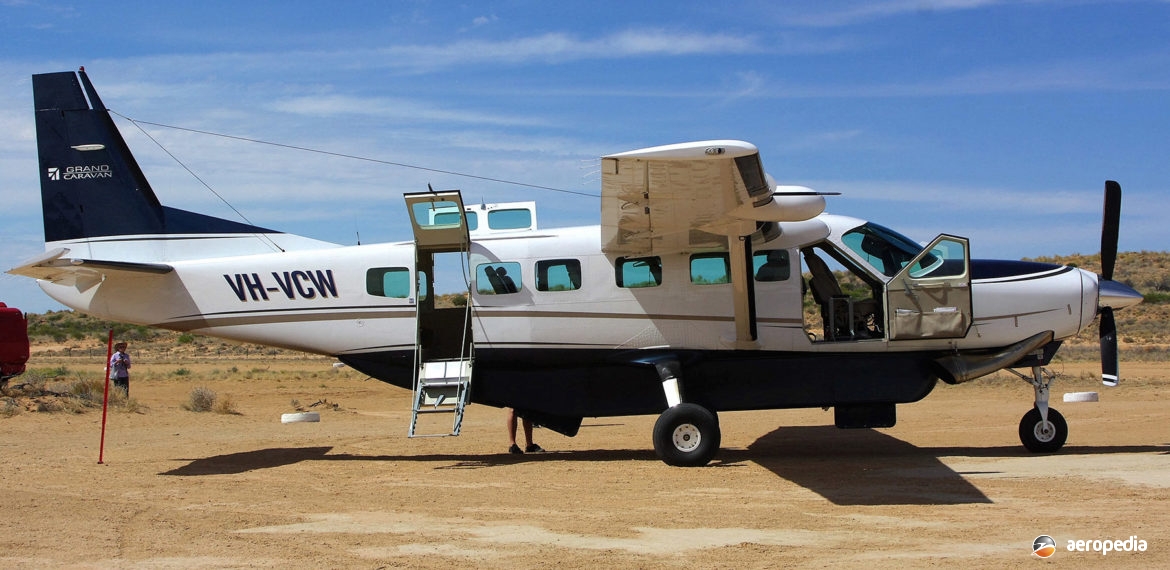Photograph:
Cessna 208B Grand Caravan VH-VCW (c/n 208B-1102) at Kalamarina, SA in November 2011 (David C Eyre)
Country of origin:
United States of America
Description:
Utility transport
Power Plant:
One 504 kw (675 shp) Pratt & Whitney Canada PT6A-114A turboprop
Specifications:
- Wingspan: 15.88 m (52 ft 1 in)
- Length: 12.68 m (41 ft 7 in)
- Height: 4.72 m (15 ft 6 in)
- Max speed at 3,048 m (10,000 ft): 341 km/h (212 mph)
- Certified ceiling: 7,620 m (25,000 ft)
- Rate of climb at sea level: 297 m/min (975 ft/min)
- Range with 45 mins reserve: 1,698 km (1,055 miles)
- Take-off run over 15 m (50 ft) obstacle: 738 m (2,420 ft)
- Landing run over 15 m (50 ft) obstacle: 547 m (1,795 ft)
- Fuel capacity: 1,009 kg (2,224 lb)
- Useful load: 1,694 kg (3,734 lb)
- Max payload: 1,564 kg (3,449 lb)
- Full fuel payload: 685 kg (1,510 lb)
- Baggage capacity: 0.9 m³ (31 cub ft)
- Loaded weight: 3,985 kg (8,785 lb)
History:
Following the success of the Models 208 and 208A, Cessna decided to extend the fuselage to permit a greater payload. Considerable interest was shown in the Caravan by operators around the world, especially freight operators such as Federal Express in the United States, and this necessitated the bringing forward of the production schedule. Two special versions were developed as pure freighters, the first of these being the Cargomaster, being based on the Model 208A, and the second being the Model 208B Super Cargomaster, this being developed in conjunction with Federal Express, an order being placed initially for 260 aircraft.
The first of this series flew in 1986 and featured a 1.22 m (4 ft) lengthening of the fuselage, an under-fuselage pannier, the deletion of the cabin windows, and a greater payload capacity. Cabin volume was increased by one-third to 9.6 m³ (340 cub ft). An extended under-fuselage pannier could also be fitted with a capacity of 3.3 m³ (115 cub ft).
Subsequently the Model 208B Grand Caravan was released in 1990 and, like the Super Cargomaster, used the stretched fuselage. It could seat up to 14 passengers and was powered by the 504 kw (675 shp) Pratt & Whitney PT6A-114 engine. Caravans have regularly been seen with under-fuselage cargo panniers, and have been fitted with amphibious floats and skis. Weather radar could be fitted on the wing leading-edge.
The max take-off weight of the Model 208B was increased to 3,985 kg (8,785 lb) which permitted a payload of 1.5 tonnes to be carried over short stages; and with full fuel it could carry a 700 kg (1,543 lb) payload. The first Model 208B flew on 3 March 1986.
A military variant known as the U-27 was demonstrated to the US Army and entered service in a number of roles, including freight delivery, logistic support, paratroop and supply dropping, medevac, electronic surveillance, forward air control, troop transport, maritime patrol, and search-and-rescue. In addition, the U-27A possessed one centreline and six wing hardpoints. Early military operators included the Liberian Army, Brazilian Air Force and the Thai Army.
The Model 208B has been offered in a number of configurations, with different types of undercarriage to permit it to operate in a wide variety of environments, including skis, larger tyres for unprepared runways, and Wipaire 8000 amphibious floats. A number have been used for skydiving with the left-side hatch changed to a roll-up door. In April 2008 the Garmin G1000 glass cockpit became standard equipment.
In 2012 Cessna announced a development, the Grand Caravan EX, and this model replaced the earlier model in production, being powered by a 646 kw (867 shp) Pratt & Whitney PT6A-140 engine, the extra power increasing cruising speed by 19 km/h to 22 km/h (12 mph to 14 mph), an increase in the rate of climb and an increase in the all-up-weight to 3,995 kg (8,807 lb).
Further modifications have been made to Model 208Bs and these have included by Aero Twin, an Alaskan company which modified Caravans by replacing the Pratt & Whitney PT6A-114 engine with the Honeywell TPE331-12JR-701S, this unit providing 790 kw (1,060 shp) but being de-rated to 634 kw (850 shp). Modifications included a new, lighter cowling and a four-blade reversing Hartzell propeller, the new aircraft having improved payload range and fuel efficiency, lower operating costs and improved anti-ice performance. When fitted with floats the water take-off of the Model 850 Grand Caravan, as it became known, was reduced from 28 to 14 seconds. In the 950 Grand Caravan model, as it became known, the Cessna 208B was fitted with a Honeywell TPE331-12JR-704AT engine providing 746 kw (1,000 shp).
In early 2023 Sydney Seaplanes, operating from Rose Bay, commenced twice daily services from Rose Bay to Lake Burley Griffin in Canberra, ACT. The company commenced using the Cessna 208B powered by Lithium Ion batteries weighing 900 kgs (1,984 lbs) provided by MagniX and Dante Aeronautical as a partner, a supplemental type certificate being obtained. The airline referred to an “aviation revolution” which would be the home of the world’s first zero emissions airline, four more aircraft to be obtained to expand the fleet. The battery packs and hydrogen fuel cells are provided in a one-drive train along with the electric engine.

